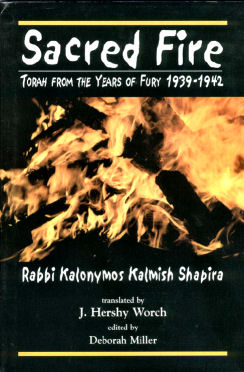Price: $45.00 includes P & P
About Sacred Fire
A Jewish philosopher once proclaimed, "There are no proofs for the existence of God, only witnesses." This translation of Rabbi Kalonymos Kalmish Shapira's Sacred Fire: Torah from the Years of Fury 1939-1942, provides English readers with access to one of the most powerful testimonies in all of Jewish literature.
Shapira, the Rebbe of the Warsaw Ghetto, was burned in the ovens of the Treblinka concentration camp in November 1943. During his fifty-five years, this gifted Hasidic Master acquired an extraordinary reputation for his brilliant teachings, deep spirituality, and personal warmth.
As the center of spiritual gravity in the largest ghetto of the Holocaust era, Shapira continued to deliver impassioned discourses on the weekly Torah portions despite terrible odds. In the winter of 1942-1943, when the Warsaw Ghetto was doomed, Reb Kalonymus carefully buried whole manuscripts that were found only after the war. Among them were these commentaries on the weekly Torah readings, together with a number of lengthy sermons delivered on the major Jewish festivals as well as a few discourses in tribute to people loved and lost.
Virtually all writings attempting to address the religious issues of the Holocaust were written after the war, from a relative distance. Sacred Fire, however, stands alone as an extended religious response to the unfolding horrors of the Holocaust from within the heart of darkness itself. As a classic Hebrew commentary on the Torah, this volume is unique. In these exceptionally creative and passionate discourses, the reader comes into the presence of a deeply sensitive individual of faith who, by means of his commentaries, is grappling with an unfolding disaster of unimaginable proportions.
Rabbi J. Hershy Worch's exquisite translations of these 'words of Torah' were a labor of love written by an insider. Worch deftly adorns the often complicated rabbinic-kabbalistic-hasidic homiletics with an eloquent and poetic English that is truthful, if not always literal. According to Worch, the most important underlying motif of Sacred Fire is God's own suffering, and the privilege of shouldering the Divine pain.
From a review by Rabbi Dr. Yakov Travis - Cleveland Ohio
Rabbi J. Hershy Worch on the Piacezna Rebbe
Who was Rabbi Kalonymus Kalmish Shapira? What makes him special?
To begin with, he was the scion of a most illustrious rabbinic and Hasidic dynasty. His peers and contemporaries considered him to be an educator par excellence. His hasidim were all aware that they were being consciously carried around in their Rebbe's heart, every moment. But he was a revolutionary as well. Rabbi Shapira epitomizes that rare gift seen in truly great people of being able to ignore all the popularly cherished beliefs and banal truisms of fashionable culture - to focus on the real question and hold to the real answer, no matter how uncomfortable. It was this certainty that moved him and allowed him to produce this most remarkable manuscript, the Sacred Fire.
Why do you think there is a recent interest in his writings?
Though he may have been a product of Nineteenth Century Polish Judaism and the milieu in which he moved, his thinking and teaching anticipated the moods and needs of Twenty-First Century humankind. He was convinced that the gift of prophecy was a reawakening fact of life for the common Jew; that greatness is the birthright of every individual Jew; and that consciousness of one's own divinity and genius is the only thing missing in modern man. We today resonate to the awakening of consciousness of our duty, not just to our own welfare, but to our cosmic duties mirrored in our care for the planet, our responsibility for the way our government operates and our respect for diversity.
If he were alive today, can you speculate where he would place himself in the spectrum of Jewish approaches? Lubavitch? Satmar? Etc.?
No, not really. I couldn't take it upon myself to speculate what he might have done had he survived, anymore than I can wonder at what Judaism would be like if Moses had made it into the Promised Land. What would the Lubavitch and Satmar Rebbes have produced had they been trapped and crushed in the Warsaw Ghetto - a pointless speculation.
From the little I know, I think [R. Shapira] would have moved to Palestine, gathering children around him.
What was Rabbi Shapira's view on suffering - why did God make a world with so much suffering?
Rabbi Shapira's view and his response and the essential teaching of Sacred Fire is that God did not make a world with so much suffering, but that God is suffering, and we are privileged to be connected to God. The very act of Creation requires God to vanquish Himself and that suffering will continue until God says, 'Enough'.
We understand that Rabbi Shlomo Carlebach introduced you to the teachings of Rabbi Shapira. What appealed to Reb Shlomo about him?
Actually, I received a copy of Rabbi Shapira's book, 'Obligations of the Student', as a gift for my Bar Mitzvah from a neighbor - a hasid of Rabbi Shapira from Warsaw. I was much too young, though, to appreciate either the book or the man, or even the history. Reb Shlomo awakened my interest in Rabbi Shapira, the Piascezna Rebbe, when he conveyed a wonderful Piascezna teaching: Do you know what the greatest miracle in the world is? Not that after everything is said and done I still have faith in God, but that God still has faith in me.
What attracts you to Rabbi Shapira? What does he teach you?
He doesn't attract me, he overwhelms me. He doesn't teach me, I only overhear him learning Torah with himself, and I am privileged to tremble in his holy presence. I overhear him comforting God, and I am allowed to shed a tear.


